Guatemala & Costa Rica
September 22 - October 10, 2004
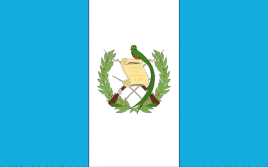
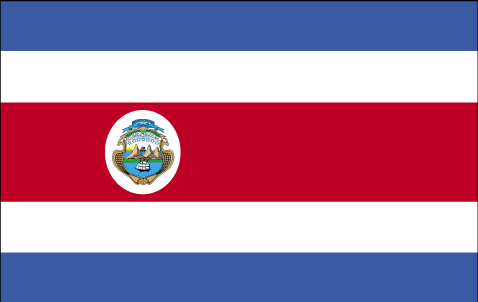
| Destination: Banana
Republic Guatemala & Costa Rica September 22 - October 10, 2004 |
 |
 |
![]() Costa Rica has been on my must see travel list for many
years. I had looked at many options and the best deal seemed to be the
Real Affordable Costa Rica trip offered by Overseas Adventure
Travel (OAT), a company specializing in small group escorted trips all over the
world. Kathy and I signed up for Costa Rica and I also signed up for the
6-night pre-trip to Guatemala even though we had some concerns about going in
the rainy season and State Department warnings regarding travel in both
countries (more about that later). I've seen many of the greatest
archaeological sites around the world but the Maya city of Tikal has been one site I thought I'd never see. The Guatemala pre-trip included Tikal and one other
Maya site so I couldn't pass up the opportunity.
Costa Rica has been on my must see travel list for many
years. I had looked at many options and the best deal seemed to be the
Real Affordable Costa Rica trip offered by Overseas Adventure
Travel (OAT), a company specializing in small group escorted trips all over the
world. Kathy and I signed up for Costa Rica and I also signed up for the
6-night pre-trip to Guatemala even though we had some concerns about going in
the rainy season and State Department warnings regarding travel in both
countries (more about that later). I've seen many of the greatest
archaeological sites around the world but the Maya city of Tikal has been one site I thought I'd never see. The Guatemala pre-trip included Tikal and one other
Maya site so I couldn't pass up the opportunity.
I flew from Sacramento, California to Guatemala City, Guatemala stopping in Dallas and Miami. I was met by my trip leader Hector and driver Edwin at the airport and by the time we got to our hotel, the Best Western Hotel Stofella, it was time for bed.
The next day I met the other six people on our tour and we began our adventure in Guatemala City which was founded in 1776 and is one of the largest cities in all of Central America. We had a brief driving/walking tour of the city seeing the Plaza de Armas, the Presidential Palace, the Eureka Chapel and the San José Cathedral. We also went to a park a saw a huge relief map of Guatemala which was quite impressive.
From Guatemala City, we drove to Antigua making our first of many "Discovery Stops" on the trip at a mud brick "factory" along the way. Antigua was founded in 1542 and designated as a UNESCO World Heritage Site. A strong earthquake destroyed much of the city in 1773 so most of the original colonial structures are gone or in ruins. They were replaced with colonial-late baroque architecture and the streets are cobblestone so Antigua is really a picturesque city.
We stayed at the colonial-style Hotel Antigua in Antigua. From the outside, all you could see were walls right on the sidewalk but the grounds and hotel were really nice. From the pool area, you could see two volcanoes, one seemingly rising just above the pool. During our free time, I had a cheeseburger by the pool and watched a great lightning show and heavy rain storm pass overhead.
| During our three days in Antigua, we had our welcome dinner, toured a coffee farm & museum (I didn't realize the process of making coffee was so involved), and a music museum. On the second day, we drove partly on the Pan American Highway to the town of Solalá where we walked through a VERY crowded market which is open there once a week. The local Indians who wear colorful clothes with a specific pattern from their home areas sell virtually everything there. It was so crowded that I almost got left behind by the group because I was trying to be polite and not push my way through. | Solalá: Indian Market |
We then saw an interesting cemetery where people are buried in small buildings in the town of Panajachel. From Panajachel, we boarded a boat for a trip on Lake Atitlán, a huge lake created when a volcano blew its top thousands of years ago. There are three volcanoes surrounding the lake - very picturesque.
I took an optional tour to Ciudad Vieja - the first capital of Guatemala located at the foot of the Agua Volcano. When it rains heavily there, the water rushes down the volcano onto the streets of the town causing flooding thus the reason for moving the capital to Guatemala City. We also stopped at a Jade Factory where President Clinton visited and bought a jade necklace.
Speaking of President Clinton, one night in Antigua, I was looking for a place to eat dinner and on the menu of one place an item that included sirloin steak, grilled chicken, chorizo and longaniza had a note next to it: "What Bill Clinton had". I figured if it was good enough for the Prez, it was good enough for me so I ordered it.
From Antigua, we drove back to Guatemala City to catch our flight to Flores. About a mile from the airport, we hit gridlock as they were having a huge parade/gathering right near the airport. Since we weren't moving, we got out and walked the last mile to the airport. I guess the traffic let up because just as we arrived, so did our van with the bags. All part of the adventure!
After a 45 minute flight to Flores, we met our local guide Luis and took a short tour of the old town located on an island in Lake Petén Itzá. This island was first inhabited by the Maya.
From Flores, we drove to our hotel called the Hotel Villa Maya, had lunch at a local restaurant and then drove to the Maya city of Yaxha. Yaxha is mostly unexcavated and is not one of the more visited Maya sites. For this reason, we had two police guards carrying automatic weapons escort our van (followed in a taxi) and then walked with us through the site. Earlier, I mentioned State Department warnings about tourists being targeted for robberies. Luis said when Yaxha first opened, there were more problems but he said the guards weren't really necessary anymore. He said OAT was the only tour operator that still provided armed escorts. The guards seemed to have a good time climbing the temples with us. Around the site, we saw Leaf Cutter Ants, Spider and Howler Monkeys, and a Toucan. The weather was hot and humid but I was happy it didn't rain. The view of the rain forest from the top of one of the temples was amazing.
| Tikal: Temple I (Temple of the Giant Jaguar) |
The next morning, we got an early start and drove for about an hour to Tikal, one of the greatest Maya cities. Tikal is huge - it is spread out over 75 square miles (120 square km) and at its peak some 1,500 years ago, 100,000 people lived there. Only a small part of Tikal has been excavated and reconstructed - about 6 square miles (9.7 square km) comprising about 3,000 structures including temples, pyramids, tombs, palaces, ball courts and terraces.We walked four miles through the city which is now a National Park and I climbed a total of three temples including Temple IV which at 213' (65 m) is one of the tallest and most massive pre-Columbian man-made structures in the Americas. In addition to all the incredible temples, buildings, stelae, stone head carvings and a ball court, we saw Oscillated Turkeys, Grey Foxes, Howler Monkeys and many birds. Luis, who grew up in the area is an expert on the Maya as well as the medicinal uses of the plants of the rain forest. He translated the hieroglyphs on a stelae, teaching us their history and explaining how advanced their culture was. |
It amazes me that all the Native Americans from Alaska to the southern tip of South America supposedly came from Asia across the Bering Straight and yet some people like the Aztecs, Incas and Maya developed far beyond others. The Maya developed math, astronomy, and an accurate calendar and yet disappeared from all of their 300 or more cities before the Spaniards arrived for a still unknown reason while less advanced cultures survived.
By the time we left Tikal, I was soaked with sweat so the pool back at the hotel was really refreshing. After a swim, I walked around the grounds spotting many different types of birds and plants.
The next day, we flew back to Guatemala City and visited a Maya museum before catching our 75 minute flight to San José, Costa Rica. Our trip leader Gilbert and driver Juan Carlos met us and took us to our hotel, the Courtyard by Marriott located in one of the more modern sections of San José. In fact, I noticed there was an Outback Steakhouse and an Office Depot right near the hotel and wondered if I really was in Costa Rica. That night, Kathy's flight arrived about 45 minutes late and she was happy to be met by Gilbert and Juan Carlos at the airport. Some tour operators will not provide transfers from the airport to the hotel for people arriving by themselves so this was a nice touch.
After breakfast the following morning, we met the other 13 people in our group on the bus and headed for Poás Volcano National Park stopping at a coffee plantation along the way. In Poás Volcano National Park, we hiked to the crater which is half-filled with a green-colored lake. There are steam vents all around the lake and it is an eerie sight. We were lucky as the lake is quite often shrouded in fog and clouds but both cleared long enough for us to get a good view.
After a lunch stop and a stop to view La Paz or "The Waterfall of Peace", we arrived at our home for the next two nights - the Sarapiquis Centro Neotropico Lodge located beside the Tirimbina Biological Reserve. The lodge grounds are landscaped with many beautiful plants and flowers. The rooms are basic and located in large thatched-roof huts that are modeled after the huts built by the Boto tribes people who inhabited the region for centuries before the Spaniards arrived. Our next door neighbors Art and Maureen invited us for a glass of champagne from a bottle that Art purchased at the airport. It was nice to just relax and watch some of the 300 species of birds in the area.
The following day, we rafted down the Río Sarapiquí. This
was Kathy's first experience with white-water rafting and the rapids were only
Class II and III so it wasn't too scary. Along the way we saw many birds,
lizards and some tiny colorful Poison Dart Frogs. After the raft trip, we ate
lunch and got a tour of the museum located next to the lodge.
We then got a tour of the
Finca Corsicana Pineapple Plant. Our guide Jeff who was from Texas explained
the whole procedure of growing and processing this most unusual fruit. After
the tour, we sampled the best pineapple and pineapple juice I have ever
had. Río Sarapiquí: that's us in front |
 Blue Jean Poison Dart Frog |
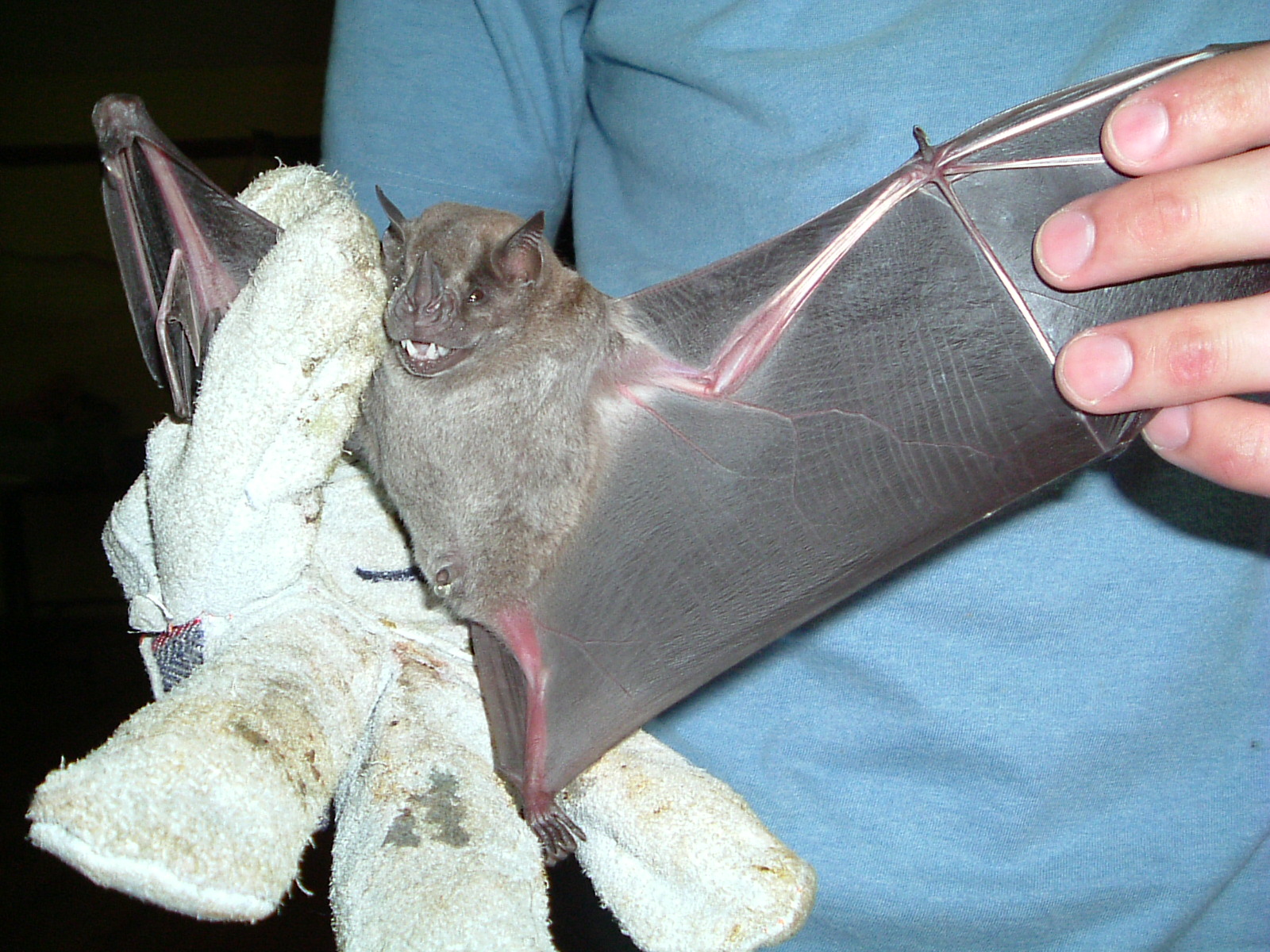 Going Batty! |
That night, we took the optional bat tour which was actually a lecture given by a local naturist named Mariano. We learned a great deal about these fascinating creatures and got to hold and release some bats they catch in nets each day for the lecture. I guess their echolocation system which keeps them from flying into cave walls and trees doesn't work on the thin nets. I think bats are really cool and we saw several different species on this trip.
After breakfast the next day, we had a guided hike through the rain forest in the Tirimbina Biological Reserve. We crossed the Río Sarapiquí on an 860' (262 m) suspension bridge, the longest in the country and saw some great wildlife including a very deadly Hog-nosed Pit Viper sleeping right on the trail. We also had to cross a smaller bridge covered with Army Ants. Of course by the time we got to the other side, they were all over us. I tried to pick one off of my sock and he clamped on with his pinchers. I pulled him off but his head stayed attached. I noticed much later that his head was still clamped on - tough little ants!
After lunch, we got on the bus for our next destination - the Bosques de Chacaqua Lodge located in a private rain forest reserve. Along the way, Gilbert broke us into groups and gave each group a shopping list for that night's dinner. He told us what to buy but wouldn't give us the spelling so we had to write each item down phonetically. He then gave us money to buy the food and dropped us off in a local market. It was really funny trying to pronounce the items correctly and the people at the market probably thought we were loco gringos but everyone got a kick out of it. That night, we all helped the cook at the lodge peel and prepare the food we bought which was also fun. I'm surprised no one cut themselves!
After breakfast and a really good Spanish lesson taught by Gilbert, we took a short drive to the local elementary school called San Rafael de Chachagua. We were met by the kids who individually took our hands and escorted us into their classroom. After playing the U.S. and Costa Rican national anthems, the kids performed traditional folk dances for us. After that, we played football (soccer) and other games with them, danced with them and had a question and answer session. Most of us brought much needed supplies (pencils, pens, etc.) for their school and it was really a great experience that you won't get on most tours.
|
From the school, we broke into four groups and our group had a home-hosted lunch at the house of one of the students named Anna. Her mom Sadie cooked us a nice lunch and afterward Anna, Kathy and I played "Go Fish". Anna only knew a bit more English than we knew Spanish but we still had fun. Sadie showed us some family photo albums and Anna showed us an interesting item: her Barbie doll complete with tattoos. This was a great way to really get to know how the local people live. |
 San Rafael de Chachagua School: Students |
That night, Gilbert gave us a great lecture with slides on volcanoes as we were heading to the very active Arenal Volcano the next day. After the lecture, it rained really hard and our room roof leaked (fortunately not on the bed). Also, while laying in bed a giant cicada landed on my arm and the next morning when I turned the shower on, a frog came out of the faucet. At breakfast the next morning, a Toucan joined us at our table looking for handouts. All part of the adventure!
The first stop the next day was the Gema Woman's Co-op. It was started by a group of women growing and selling medicinal herbs that they claim can cure just about anything. Their husbands thought the co-op didn't have a chance and didn't support them but the women persevered and the co-op is still doing good business.
The next stop was a farm operated by Juan Batista, the principle of the school we visited who took a leave of absence to pursue his first love - organic farming. He showed us many unusual fruits and vegetables he's growing and we even got to plant and harvest some. We also squeezed sugar cane through a ringer with two people on each side cranking the handles and drank the juice. Next, Juan brought out a clear jug of Sugar Cane moonshine (180 proof). Apparently, stills are tolerated as long as the owner doesn't sell the product. After a crazy toast translated by Gilbert, we downed the shots. It tasted like rum and had a REAL kick to it! After that we staggered over to the dining area where Juan's wife served a great lunch.
We arrived at the Volcano Lodge in the late afternoon where Kathy and I headed straight for the pool. While using the spa and pool, we kept an eye on the Arenal Volcano which was located right across the street from the lodge. Arenal Volcano came back to life on July 29, 1968 and the eruption killed 87 people in the nearby villages of Tabacon and Pueblo Nuevo. It has been active ever since emitting steam, ash, lava flows and periodically very large pyroclastic flows. The peak was shrouded in clouds most of the time but once in awhile, the clouds would clear and we could see the orange glow of lava flows.
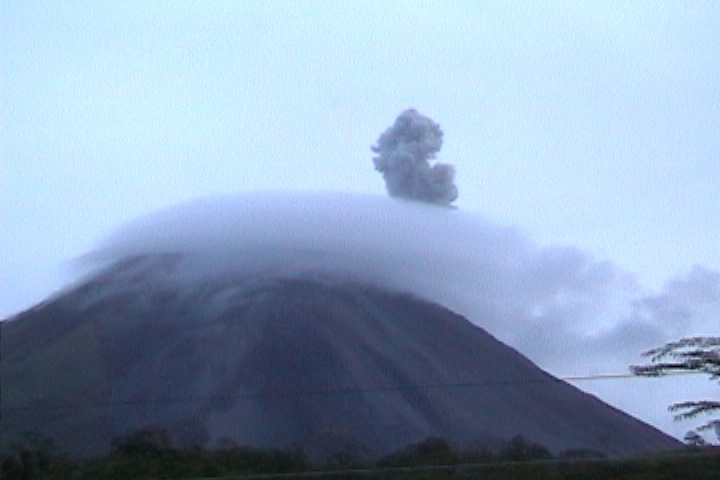 Arenal Volcano: Ash Cloud Eruption |
If you want, the lodge will call your room if there is an eruption at night. The first night, they called us around 9:45 p.m. so we ran outside and caught a glimpse of a flow. The next night they didn't have to call as around 3:00 a.m. I awoke to what sounded like thunder. The next day while relaxing by the pool, we heard a rumble and I grabbed my video camera just in time to capture a big ash cloud drifting away with the wind. Of all the volcanoes I've seen around the world, this was the first time I have seen one actually erupt and it was awesome! |
We took a day trip from the Volcano Lodge heading north around Lake Arenal toward the Nicaragua border and took a boat ride on the Río Frío. This was our first of two boat rides and the rivers are really the place to see the wildlife. We saw Caimans, Howler and White-faced Monkeys, Two and Three-toed Sloths, a Slider Turtle and hundreds of birds.
During the bus rides, Gilbert told us many interesting facts about Costa Rican history and one story really stuck in my mind. It was about a man named William Walker who was born in 1824 in Tennessee, graduated from the University of Nashville at the age of 14 and by 19 earned a medical degree. He practiced medicine in Philadelphia, studied law in New Orleans, and then became co-owner of a newspaper where Walt Whitman worked. He then moved to San Francisco where he worked as a reporter before setting up a law office in Marysville, California.
When he was 29, Walker became the leader of a group plotting to detach parts of northern Mexico. Recruiting a small army, he sailed to Baja California and conquered La Paz, declaring himself president of Lower California. He later led armies in wars in Nicaragua and invaded Costa Rica. His enemies included Cornelius Vanderbilt and the British navy. He had himself elected president of Nicaragua but in 1857 surrendered to a U.S. naval officer and returned to the United States.
In 1860 Walker sailed south with another army he had raised. He landed in Honduras planning to march overland to Nicaragua but was soon captured by the British who turned him over to the Hondurans. Six days later at the age of 36, he was executed by a firing squad ending his bid to conquer Central America. One of Costa Rica's greatest national heroes is Juan Santamaria, a young drummer boy who torched a fort in which Walker's army was encamped.
After the second night at the Volcano Lodge we drove to Guanacaste Province where we would stay for the next two nights at the Buena Vista Lodge located in the tropical dry forest. Along the way, we stopped at the town of Tilaran where Gilbert grew up. He showed us the house he lived in, the market he shopped at and the primary school he attended. At the school, the kid in him came out as he jumped over a rail - something he told us the students were forbidden to do.
Even though this was the tropical dry forest, it was the rainy season so the next morning we woke up at 5:10 a.m. to eat breakfast and be ready for the optional zipline forest canopy ride at 7:00 a.m. hopefully beating the rain. After a 15-minute hike up the hill, we got into our harnesses, donned our leather gloves, wrote our last will and testaments and whizzed down a cable strung between ten trees. The only brake is your gloved hand on the cable. I actually got some video while on a few of the sections. It was a blast!
|
Next up was our horseback ride to the thermal hot springs baths about 5 miles away. Kathy and I brought our rain gear but it wasn't raining yet so we put the gear in our packs and onto a trailer pulled by a tractor that went along with us (for those who didn't want to ride horses). Shortly after we started out, the downpour began and we all got totally soaked. Once we got to the thermal bath area, we spent a short time in the steam room before going out and rubbing mud all over ourselves. After the mud cured every ailment we had, we were washed off and spent the rest of the time relaxing in the natural hot baths located in the lush forest setting. |
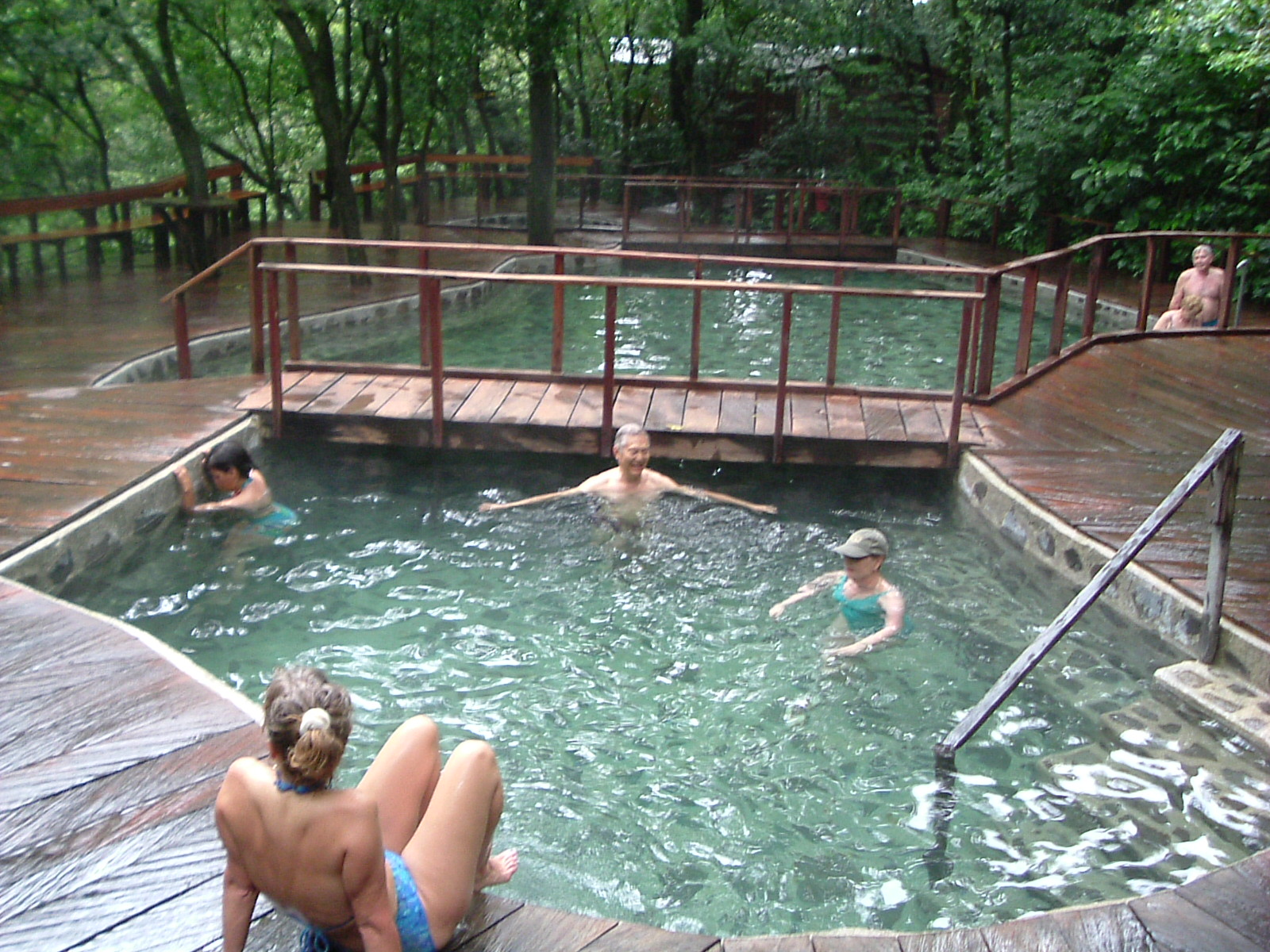 Relaxing at the Natural Hot Spring Baths |
When we were ready to head back, it was still raining and about half of the people in our group chose to ride the trailer back. Kathy and I opted for the true outdoor experience and put our raingear on over our wet clothes, got on our horses and had a wild ride back. This was only the third time in my life I have ridden a horse and the conditions were less than ideal. They let the horses with no riders go back on their own in a pack that we had to ride with and the horses were all in a hurry to get back and out of the rain. The trail was very steep in some places and the water was flowing pretty good across some of the low areas we crossed. My horse tripped once and my leg got squeezed between horses a few times but we made it back and survived with only a mild case of saddle soreness. This was the only time on our trip where rain really affected our activity so we couldn't complain.
The next day, we headed south through cattle ranching areas and the tropical humid forest. We stopped at the Monteverde ice cream stand where Gilbert bought us our choice of a milk shake or ice cream. Monteverde was founded in 1951 by a group of 44 North American Quakers, most from Fairhope, Alabama who as a matter of conscience had refused to register for the draft. Led by John Campbell and Wilford "Wolf" Guindon, they chose Costa Rica for a new home because it had done away with its army. With the help of their Costa Rican neighbors, the Quakers began developing the community that exists today making and selling cheese and eventually operating the ice cream stand.
At around noon, we arrived at the last lodge we would stay at called the Hotel Villa Lapas located right in the tropical forest - another great location with beautiful grounds and wildlife right outside our room. It was at this lodge that I saw a wild Scarlet Macaw flying by for the first and only time.
In the afternoon, we took a two hour river cruise on the Río Torcoles where we saw all kinds of wildlife in the mangrove forest including crocodiles and a few Jesus Christ Lizards (unfortunately, none felt like walking on water for us). Of course we saw many species of birds again.
That night, we decided to see the optional folk show with dinner at the Santa Lucia Village replica located right on the grounds of our hotel. Walking around the village to see the cantina, church and shops at night, it was like an obstacle course trying not to step on the giant frogs. The musical show depicted the history of Costa Rica from the time of the native inhabitants through the Spanish conquest and independence. It was nothing spectacular but the performers really worked hard and we enjoyed the show.
 Punta Coral Private Beach: Pura Vida! |
The next day was a real treat. After a non-stop trip full of adventure and discoveries, we boarded a catamaran and cruised to a private beach called Punta Coral which was reserved only for our small group. Punta Coral is located on the easternmost tip of the Peninsula of Nicoya. We had many options here - swim, snorkel, hike, sea kayak, or just vegetate in a hammock with a cold beer. It was paradise! Kathy and I tried sea kayaking for a while and then they served the best lunch on the whole trip - Mahi Mahi. We were serenaded by a 92-year-old marimba player as we ate, drink wine and took in the beauty of the place. |
After lunch (and a few glasses of wine on top of the beer), I curled up in a hammock but after a while somehow found the strength to get back in the sea kayak and paddled all the way across the Gulf of Nicoya.
The private beach and catamaran are owned and operated by an American and his wife from San Francisco who fell in love with the place about 20 years ago. Their daughter happens to be a trip leader for OAT. We laid out on the net of the catamaran on the cruise back and saw a spectacular sunset and double rainbow - a perfect ending to a perfect day!
On our last day in Costa Rica, we drove back to San José where Gilbert gave us a tour of the National Theater which is known as "the Jewel of the Nation" because of its ornately decorated interior. Then we visited the National Museum which displays 10,000 years of Costa Rican history. My favorite items there are the perfectly carved stone spheres found in Central America. Some are as big as six feet in diameter and their origin and purpose are real mysteries.
That night we were driven to a restaurant called Tiquicos located 4,000' (1,962 m) up the side of a mountain overlooking the city for our farewell dinner. The clouds parted a few times allowing a spectacular view of San José.
While we were having dinner, Costa Rica was playing Guatemala in a World Cup football qualification match and we knew Gilbert and Juan Carlos were dying to watch the big game. After dinner we went back to the bus and Juan Carlos was watching the game on a small portable TV in the bus. On the drive back to the hotel, Costa Rica scored a goal so we all cheered. Kathy and I watched the end of the game back at the hotel lobby. Costa Rica won 5-0.
The next day, we got up early and were driven to the airport. At the airport, the Costa Rican football team entered the terminal and the people there gave them a huge ovation. They were headed for their next game in Canada and as it turned out, were on the same flight Kathy was taking to Dallas. I said adios to Kathy and we got on our separate flights going on very different routes and somehow ended up at home within an hour of each other.
I ended up traveling on the buses 1,200 miles (1,931 km) in both countries. The food on the trip (almost all meals were included) was good - they really like beans and rice in both countries and it seems like that was offered at every meal including breakfast. We also had lots of chicken, fish and beef as well as all types of vegetables. We sampled several of the local beers and all were quite good.
The rooms at all the lodges were clean and comfortable and many had beautiful grounds landscaped with many unusual orchids and plants. I once stayed in a lodge in the Amazon that had no electrically or hot water so these lodges were luxurious compared to that.
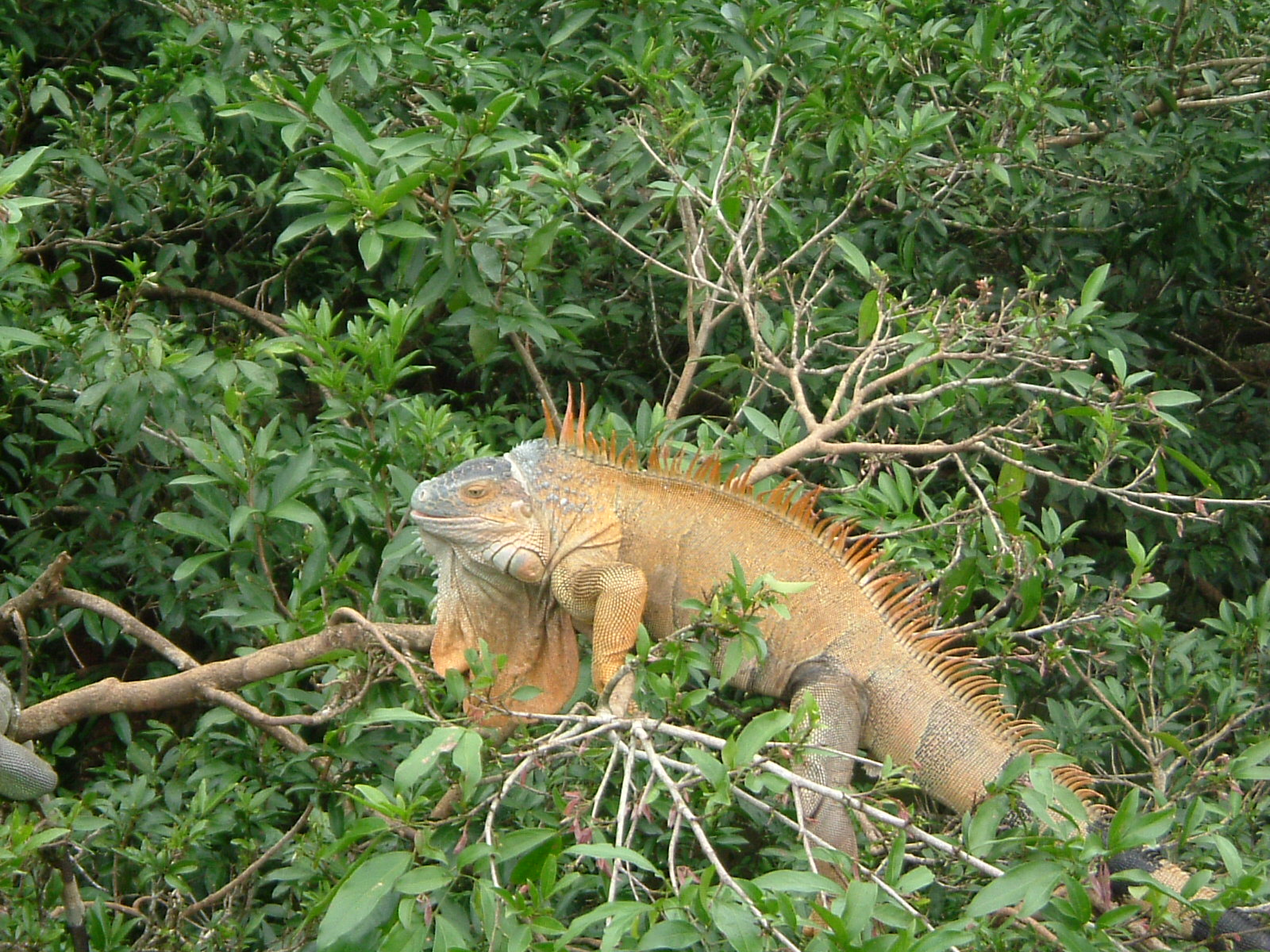 Male Green Iguana |
Except for the horseback ride to the hot springs, the rain did not really affect us. It was the rainy season but the rain usually didn't start until the afternoon or night so we felt very fortunate. We did notice a lot of pot holes in the road due to the rain but Juan Carlos showed great skill maneuvering around them. Gilbert said you can spot the drunk drivers because they are the only ones driving straight. According to our check lists, we saw at least 70 species of birds in Costa Rica and I also saw many different birds in Guatemala. Unfortunately, we never saw the very elusive Quetzal, a long-tailed bird sacred to the Mayas. |
We saw several unusual animals including an Agouti which looks like a large rat and a Coatimundi which is related to the raccoon. At one "Discovery Stop", we walked onto a bridge and viewed a large number of Green Iguanas basking in the sun up in the tree branches.
In Costa Rica and Guatemala, many places accept U.S. dollars and in Costa Rica, I even found ATM machines that gave you a choice of dollars or colonés. I withdrew dollars once and didn't pay one cent in fees either there or with my financial institution.
Gilbert, our OAT trip leader in Costa Rica was probably one of the best trip leaders I have had on any trip. He always turned toward us when talking to us on the bus (I would have gotten car sick), knew his natural and political history, local culture, and threw in just enough humor to keep our attention. He is an expert birder who brought his own very expensive Swarovski HD spotting scope and gave us all bird/animal check list booklets that he made himself. In other words, he went above and beyond what was required of him.
|
If you like eco/adventure travel, I highly recommend this trip. I would definitely take another OAT trip. They just put together a new trip called Route of the Maya which visits several of the greatest Maya sites in Belize, El Salvador, Honduras and Guatemala and I plan on taking that trip someday. Finally, the Costa Ricans who call themselves Ticos have a saying: Pura Vida! In Spanish it literally means "Pure Life" but it is also a uniquely Costa Rican idiom for "everything is great!". Costa Rica is also one of the few countries in the world that doesn't have an army. It's too bad the rest of the world can't follow their example. |
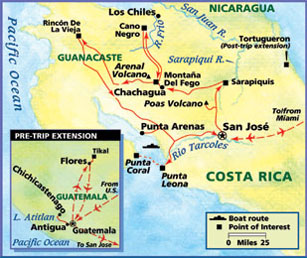 Trip Routes |